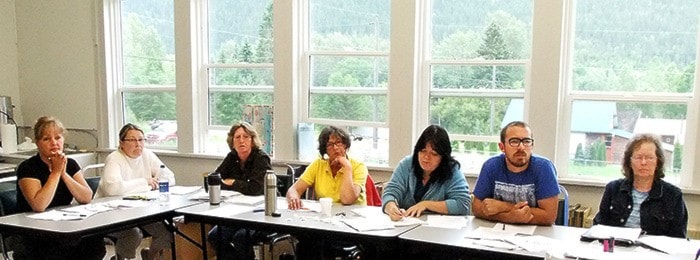As outlined in an earlier article, Avola's log schoolhouse and the playground nearby were the major topics of interest during an open house and services committee meeting held in the schoolhouse on June 18.
More than 30 people attended the combined events.
 The fate of the equipment in the playground was a major topic of concern in letters received by the services committee, even though there are presently no children living in Avola.
The fate of the equipment in the playground was a major topic of concern in letters received by the services committee, even though there are presently no children living in Avola.
“My grandchildren play in the park plus families with children stop off the highway for a rest,” wrote Avola resident Marilyn Bryce.
The factory-built playground being proposed was a “cookie-cutter” approach and did not fit in with the rest of the community, Eleanor Deckert felt.
She presented a number of examples of playgrounds made with more natural-looking wood that she had found on the Internet.
The TNRD is required to replace a number of items in the playground for insurance reasons, said services coordinator Sherri Madden in a report.
These include a merry-go-round, steel slide, creative climber playground, teeter-totter and dino climber.
The non-conforming assets could be sold to community members but only if the TNRD is not held liable afterwards.
Madden recommended buying a new play structure and having the manufacturer install it, at a cost of $36,000. She also recommended repositioning the swing set and bringing it up to standard.
However, after some procedural wrangling, the services committee instead voted to delay removal of the existing play structures until the spring of 2014.
To stain or not to stain
What color to use to stain the log schoolhouse's exterior, and even whether or not to stain, were other sources of controversy.
 In a letter to the committee, contractor Brad Dohms said staining the outside of the structure would help protect the logs from further decay from the sun, help prevent bug infestation, and allow him to match up the color of log patches with the remainder of the logs.
In a letter to the committee, contractor Brad Dohms said staining the outside of the structure would help protect the logs from further decay from the sun, help prevent bug infestation, and allow him to match up the color of log patches with the remainder of the logs.
Dohms proposed to restore the building by:
• the removal of mortar;
sandblasting the logs with walnut shells to remove the oxidized wood but retain the original “graying” of the logs;
• put in log patches where the wood has decayed and left a void;
• match the color of the filler epoxy, reinforce the logs with wood petrifier where needed;
• stain the logs; and
• chink the logs.
Before getting the present contract for the Avola schoolhouse, Dohms had done extensive renovation work to the Blackpool and Upper Clearwater community halls.
Participants in the open house held before the services committee meeting were given two choices for the new chinking – basically a light tan and a darker tan.
Even though the original chinking was white, using white chinking when restoring an old building would result in an unnatural appearance, Dohms advised.
The services committee eventually voted to leave the decision on the color of the stain to the contractor. The committee also accepted a recommendation from those at the open house that the lighter tan chinking be used.
